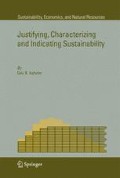Weitzman provides a foundation for NNP as the stationary equivalent of a wealth-maximizing path when there is a constant interest rate and no exogenous technological progress. Here, the implications of Weitzman’s foundation are explored in a case encountered in resource models, i.e., the case of nonconstant interest rates. In a setting that allows for exogenous technological progress, an expression for NNP is obtained that adjusts Green NNP for anticipated capital gains and interest rate effects to produce a measure that indicates sustainability. This result is important when measuring the relative sustainability of resource rich and resource poor countries.
Access this chapter
Tax calculation will be finalised at checkout
Purchases are for personal use only
Preview
Unable to display preview. Download preview PDF.
References
Aronsson, T. and Löfgren, K.-G. (1993), Welfare consequences of technological and environmental externalities in the Ramsey growth model, Natural Resource Modeling 7, 1–14
Aronsson, T. and Löfgren, K.-G. (1995), National product related welfare measures in the presence of technological change: Externalities and uncertainty, Environmental and Resource Economics 5, 321–332
Asheim, G.B. (1986), Hartwick’s rule in open economies, Canadian Journal of Economics 19, 395–402 [Erratum 20, (1987) 177] (Chap. 9 of the present volume)
Asheim, G.B. (1988), Rawlsian intergenerational justice as a Markov-perfect equilibrium in a resource technology, Review of Economic Studies 55, 469–483 (Chap. 6 of the present volume)
Asheim, G.B. (1991), Unjust intergenerational allocations, Journal of Economic Theory 54, 350–371 (Chap. 7 of the present volume)
Asheim, G.B. (1994), Net national product as an indicator of sustainability, Scandinavian Journal of Economics 96, 257–265 (Chap. 15 of the present volume)
Asheim, G.B. (1996), Capital gains and ‘net national product’ in open economies, Journal of Public Economics 59, 419–434 (Chap. 10 of the present volume)
Brekke, K.A. (1996), Economic Growth and the Environment. Edward Elgar, Cheltenham, UK
Calvo, G. (1978), Some notes on time inconsistency and RawlsŠ maximin criterion, Review of Economic Studies 45, 97–102
Dalton, H. (1920), The measurement of the inequality of incomes, Economic Journal 30, 348–361
Dasgupta, P.S. (1996), The economics of the environment, Environment and Development Economics 1, 387–428
Dasgupta, P.S. and Heal, G.M. (1974), The optimal depletion of exhaustible resources, Review of Economic Studies (Symposium), 3-28
Dixit, A., Hammond, P. and Hoel, M. (1980), On Hartwick’s rule for regular maximin paths of capital accumulation and resource depletion, Review of Economic Studies 47, 551–556
Fisher, I. (1989), The Nature of Capital and Income. Macmillan, New York
Hartwick, J.M. (1977), Intergenerational equity and investing rents from exhaustible resources, American Economic Review 66, 972–974
Hartwick, J.M. (1990), National resources, national accounting, and economic depreciation, Journal of Public Economics 43, 291–304
Hartwick, J.M. (1995), Constant consumption paths in open economies with exhaustible resources, Review of International Economics 3, 275–283
Hartwick, J.M. and Long, N.V. (1999), Constant consumption and the economic depreciation of natural capital: The non-autonomous case, International Economic Review 40, 53–62
Hicks, J. (1946), Value and capital, 2nd edition. Oxford University Press, Oxford
Kemp, M.C. and Long, N.V. (1996), On the evaluation of social income in a dynamic economy: Variations on a Samuelsonian theme, in Fewel, G.R. (ed.), Samuelson and Neoclassical Economics. Kluwer, Dordrecht
Kemp, M.C. and Long, N.V. (1998), On the evaluation of national Income in a dynamic Economy: Generalization, in Jäger, K. and Koch, K.-J. (eds.), Trade, Growth, and Economic Policies in Open Economies. Springer, Berlin Heidelberg New York
Lindahl, E. (1933), The concept of income, in Bagge, G. (ed.), Economic Essays in Honor of Gustav Cassel. George Allen & Unwin, London
Mäler, K.-G. (1991), National accounts and environmental resources, Environmental and Resource Economics 1, 1–5
Nordhaus, W.D. (1995), How should we measure sustainable income? Cowles Foundation DP 1101, Yale University
Pearce, D.W. and Atkinson, G.D. (1993), Capital theory and the measurement of sustainable development: An indicator of “weak” sustainability, Ecological Economics 8, 103–108
Sefton, J.A. and Weale, M.R. (1996), The net national product and exhaustible resources: The effects of foreign trade, Journal of Public Economics 61, 21–47
Solow, R.M. (1974), Intergenerational equity and exhaustible resources, Review of Economic Studies (Symposium), 29-45
Usher, D. (1994), Income and the Hamiltonian, Review of Income and Wealth 40, 123–141
Vincent, J.R., Panayotou, T., and Hartwick, J.M. (1997), Resource Depletion and Sustainability in Small Open Economies, Journal of Environmental Economics and Management 33, 274–286
Weitzman, M.L. (1976), On the welfare significance of national product in a dynamic economy, Quarterly Journal of Economics 90, 156–162
Weitzman, M.L. (1997), Sustainability and technological progress, Scandinavian Journal of Economics 99, 1–13
Withagen, C. (1996), Sustainability and investment rules, Economics Letters 53, 1–6
Rights and permissions
Copyright information
© 2007 Springer
About this chapter
Cite this chapter
(2007). Adjusting Green NNP to Measure Sustainability. In: Justifying, Characterizing and Indicating Sustainability. Sustainability, Economics, and Natural Resources, vol 3. Springer, Dordrecht. https://doi.org/10.1007/978-1-4020-6200-1_16
Download citation
DOI: https://doi.org/10.1007/978-1-4020-6200-1_16
Publisher Name: Springer, Dordrecht
Print ISBN: 978-1-4020-6199-8
Online ISBN: 978-1-4020-6200-1
eBook Packages: Earth and Environmental ScienceEarth and Environmental Science (R0)

